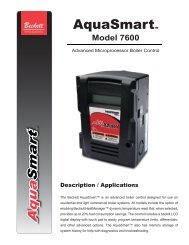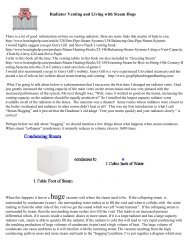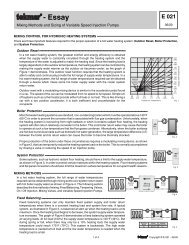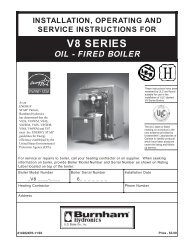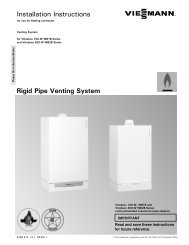Steam Locomotive Firebox Explosion on the Gettysburg Railroad ...
Steam Locomotive Firebox Explosion on the Gettysburg Railroad ...
Steam Locomotive Firebox Explosion on the Gettysburg Railroad ...
You also want an ePaper? Increase the reach of your titles
YUMPU automatically turns print PDFs into web optimized ePapers that Google loves.
gage cock 17 above <strong>the</strong> crownsheet was 3 1/4<br />
inches. 18<br />
In accordance with Canadian Pacific<br />
policy, <strong>the</strong> crown stays, which supported <strong>the</strong><br />
crownsheet from <strong>the</strong> boiler roof sheet, 19<br />
were alternating rows of straight-thread and<br />
butt<strong>on</strong>-head crown stays. (See figures 6 and<br />
7.) The first five rows from <strong>the</strong> rear tubesheet<br />
knuckle (next to <strong>the</strong> tubes and flues)<br />
were straight-thread crown stays followed by<br />
rows of butt<strong>on</strong>-head crown stays. The boiler<br />
had been made that way so that if <strong>the</strong><br />
crownsheet failed because it was not covered<br />
by water, it would be pushed off <strong>the</strong> straightthread<br />
crown stays first. C<strong>on</strong>sequently, although<br />
<strong>the</strong> crownsheet would buckle, it<br />
would be retained for a time by <strong>the</strong> butt<strong>on</strong>head<br />
crown stays. Thus, if <strong>the</strong> crownsheet<br />
failed because of too little water, <strong>the</strong> failure<br />
would occur progressively and in stages,<br />
ra<strong>the</strong>r than instantaneously and catastrophically.<br />
20 O<strong>the</strong>r than being designed to make a<br />
failure a progressive, ra<strong>the</strong>r than an instantaneous,<br />
event, <strong>the</strong> boiler did not have any<br />
low-water protecti<strong>on</strong> devices.<br />
Cab Equipment and Arrangement--The cab<br />
of locomotive 1278 surrounded <strong>the</strong> backhead<br />
of <strong>the</strong> boiler. 21 (See figure 8.) A number of<br />
devices, including gages and <strong>the</strong> water glass,<br />
were mounted <strong>on</strong> <strong>the</strong> backhead. The backhead<br />
was also <strong>the</strong> locati<strong>on</strong> of <strong>the</strong> back of <strong>the</strong><br />
firebox and <strong>the</strong> firebox door. Below <strong>the</strong><br />
firebox door was <strong>the</strong> automatic stoker-auger<br />
entrance used to deliver coal to <strong>the</strong> firebox.<br />
The backhead had a number of washout<br />
plugs. 22 The engineer’s seat was to <strong>the</strong> right<br />
side of <strong>the</strong> boiler and slightly to <strong>the</strong> rear of<br />
<strong>the</strong> backhead. Similarly, <strong>the</strong> fireman’s seat<br />
was al<strong>on</strong>g <strong>the</strong> left side of <strong>the</strong> boiler.<br />
On <strong>the</strong> engineer’s side of <strong>the</strong> cab were <strong>the</strong><br />
air-brake c<strong>on</strong>trols and gages, throttle lever,<br />
reverser (valve cut-off c<strong>on</strong>trol), boiler-pressure<br />
gage, injector operating lever, 23 <strong>the</strong><br />
three gage-cock operating handles, and a<br />
number of o<strong>the</strong>r accessory c<strong>on</strong>trols, handles,<br />
and levers. On <strong>the</strong> fireman’s side of <strong>the</strong> locomotive<br />
cab were a number of gages and<br />
c<strong>on</strong>trols for managing <strong>the</strong> boiler and steam<br />
producti<strong>on</strong>. Three gages—stoker jet-pressure<br />
gage, steam-heat pressure gage, and feedpump<br />
pressure gage—had been removed<br />
from a mounting plate <strong>on</strong> <strong>the</strong> fireman’s<br />
side, 24 leaving <strong>on</strong>ly a stoker-engine steampressure<br />
gage and a boiler-pressure gage.<br />
(See figure 9.)<br />
17 Gage cocks are used as a backup system for <strong>the</strong><br />
water glass.<br />
18 The gages are positi<strong>on</strong>ed so that <strong>the</strong> lowest reading<br />
<strong>on</strong> <strong>the</strong> gage will indicate more than 3 inches of water<br />
over <strong>the</strong> crownsheet, which is <strong>the</strong> minimum as<br />
required by 49 CFR 230.37.<br />
19 The outer boiler shell above <strong>the</strong> crownsheet.<br />
20 Note that (1) such a failure will still, as in this<br />
accident, be very sudden and “explosive” and (2) no<br />
c<strong>on</strong>structi<strong>on</strong> method will prevent a catastrophic<br />
failure, although it may attenuate <strong>the</strong> damage.<br />
21 The backhead is <strong>the</strong> rearmost boiler sheet, which is<br />
located in <strong>the</strong> cab.<br />
22 Boiler designers incorporate a minimal but<br />
necessary number of washout plugs in a boiler to<br />
ensure that it can be thoroughly washed and cleaned<br />
of <strong>the</strong> sediment that c<strong>on</strong>tributes to scale.<br />
23 The injector is a device for forcing water into a<br />
steam boiler. A jet of steam imparts its velocity to <strong>the</strong><br />
water and thus forces it into <strong>the</strong> boiler against <strong>the</strong><br />
boiler pressure. The injector <strong>on</strong> locomotive 1278 was<br />
of <strong>the</strong> lifting type, which is generally used when <strong>the</strong><br />
locomotive is standing still.<br />
24 The missing gages were identified from a<br />
photograph of locomotive 1278 taken several years<br />
before this accident.<br />
14



